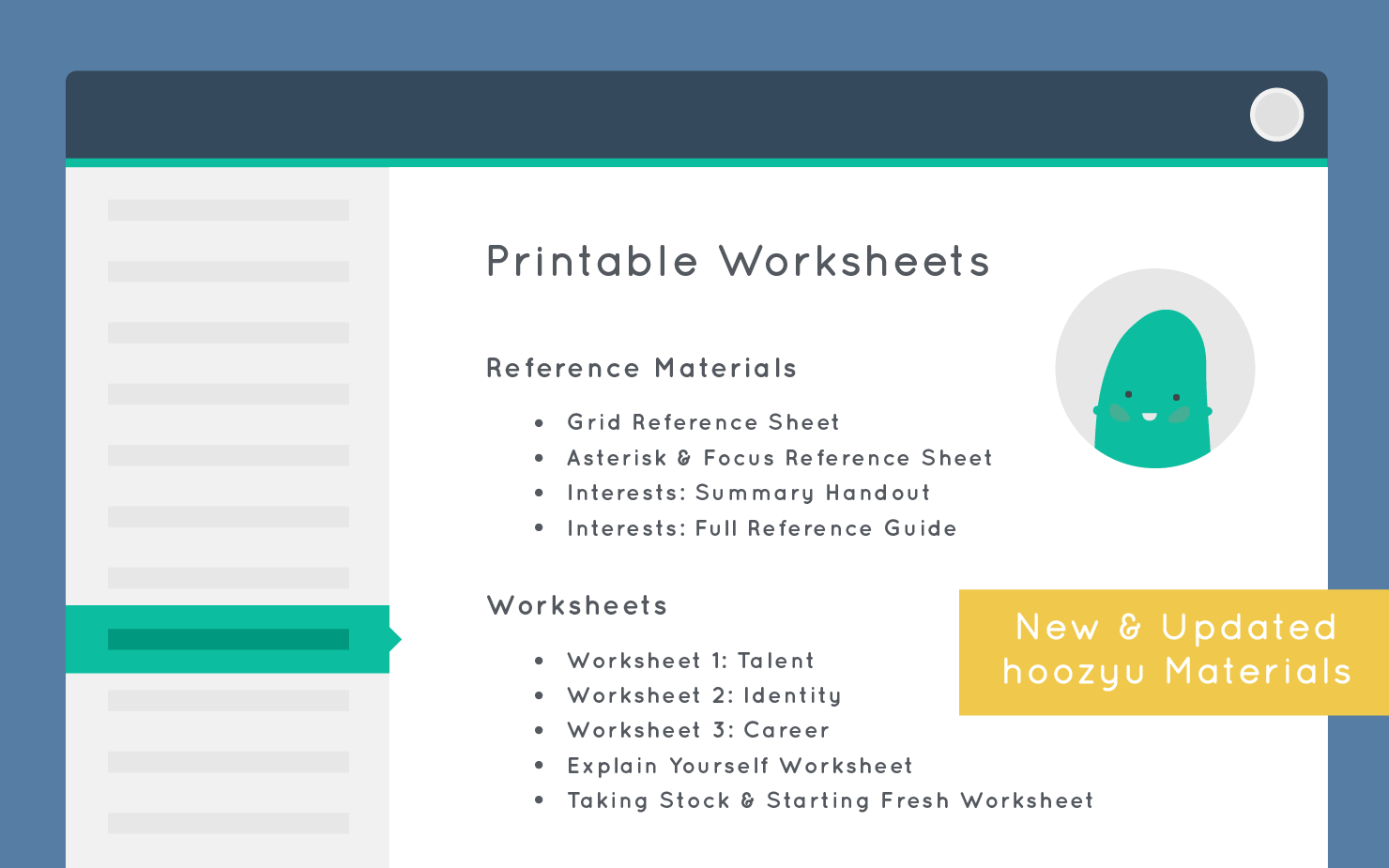
Updated hoozyu worksheets & materials
Last week we updated our hoozyu Printable Worksheets and Reference Materials on the hoozyu platform! The new versions feature a lot of the the same basic content but redesigned and rewritten for greater clarity and usability.
If you’ve never completed the hoozyu worksheets previously, they are a great tool to get you thinking about 3 specific areas: Talent, Identity and Career.
If you have completed them in the past, now might be a great opportunity to go through again, and also to revisit what you wrote previously. What has changed for you since then? How have you progressed?
The 3 main worksheets are each 3 pages long, and take about 20 minutes to complete.
As well as these, you’ll find two new additions: the hoozyu Explain Yourself worksheet, and the Taking Stock & Starting Fresh worksheet mentioned in last month’s newsletter.
Along with the worksheets, we’ve also updated the existing reference materials, and added an additional handout: the Asterisk & Focus sheet.
If you’ve never made use of the reference materials before, here’s a couple of ideas to get you started!
First up: The Grid Reference Sheet.
This is a summary featuring basic descriptions for each Grid symbol, in each of the 4 colour variations. It’s useful not only to remind you of what your own scores tell you, but also as an indicator of how other people differ from you in their Interests, Usual, Need and Stress behaviours.
Here’s an activity you can complete using the Grid Reference Sheet:
For each of the 4 symbols - Asterisk, Diamond, Circle, and Square - circle the description that matches your colour for that symbol.
Now write yourself a summary, using those sentences as an outline. For example you might say:
I enjoy getting stuff done and see things finished! I am usually sensitive, insightful, reflective, and I value in-depth relationships. I need freedom from unnecessary rules and procedures, a clear sense of authority (who’s in charge & what rules are being enforced?), and reward and feedback for work I’ve done. If my needs aren’t met I can tend to drop the plan, get easily distracted and become argumentative and self-promotional.
(Can you work out which colour each symbol was in that example?)
If your friends or family members have done hoozyu too, you could get them to write a summary of their own, and compare your needs and usual behaviours with each other. Are there more similarities or differences between your scores?
Does your Usual behaviour match their Need? Does their Usual match your Need? What might this mean for each of you?
Asterisk & Focus Reference Sheet
Similarly to the Grid Reference Sheet, the Asterisk & Focus Reference Sheet features descriptions for each colour variation, but this time looking only at the Asterisk (My Interests) and the Organisational Focus bar (My Focus).
The reason these 2 are placed together is that they both relate to motivation. (While the other Grid symbols relate to behaviour & perception.)
The Asterisk tells us what area we are drawn to, while our Focus tells us the kind of tasks we want to focus on.
If someone were to write a summary using this reference sheet it might say:
I am drawn to areas where engaging with people, communication and selling are central. But I want to focus on tasks which involve strategy, innovation, design and ideation.
Give it a go - what would your motivation summary say?
Interests: Summary Handout & Full Reference Guide
There are 2 reference materials devoted to the individual Areas of Interest. The first is a simple one-page summary - which is useful (and great for sticking somewhere as a reminder!) but not very detailed.
The second is a 10-page, in-depth look at each of the Interests, and it’s well worth taking a look and learning a bit more about what these scores really mean.
To get the most out of the Full Reference Guide I suggest having the list of your own Interest scores in front of you, so you can see the number you scored beside each of the 10 Interests.
The guide is arranged alphabetically so it starts with Artistic and ends with Social Service. As you go through, highlight on each page whether you have a High (70 or above) or Low (20 or below) score for that Interest - or if you’re somewhere in-between.
If you’re High or Low you can focus on the relevant section, if you’re in the middle have a read of both the high and low descriptions, and highlight the parts that sound true for you.
By the time you’ve finished going through you should have a much clearer picture of the things that do, and don’t, energise and motivate you!
